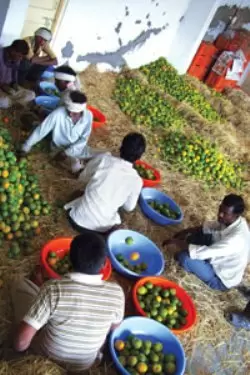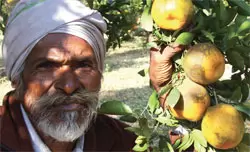The Nagpur orange was saved, thanks to sustainable cultivation

24-May-2012
Vol 3 | Issue 21
A beaming Uday Wath hugs the trunk of his sturdy, disease-free Nagpur orange tree. All around him are trees drooping with the fruit, large and healthy. The tree trunks are singularly free of both telltale gummosis wounds and bluish white bordeaux paste, the chemical meant to prevent them.
Not more than four years ago, these trees were on the verge of death. The cause: gummosis, a lingering disease caused by one or more species of the fungus, Phytophthora.
 |
|
Oranges are sorted for sale at a wholesale market in Nagpur (Photo: Aparna Pallavi)
|
As gum oozes out of the trunk, the tree weakens and eventually dies. “There was a time when I was actually thinking of felling the orchard,” he says. That’s when Wath turned organic.
“As a last ditch effort I gave up chemicals,” he says. He regularly started spraying jeevamrut on the trees.
This is the fermented extract of cow dung, cow urine and neem leaves, known for its anti-fungal properties and high nitrogen content. He applied its solid residue to the wounds. He also began mulching the weeds.
It took not more than a year for the trees to recover. The yield has now grown to 2,000 fruits per tree per season.
“There is no trace of Phytophthora in my orchard, though all the orchards in my village are infected,” he says proudly.
Wath is one of a small group of organic orange cultivators in Vidarbha. Organic cultivation has helped them cut cost, improve yield and find practical and cost-effective solutions to the intractable problem this world-famous crop is riddled with.
Vidarbha’s signature Nagpuri santra was created 150 years ago by grafting a wild orange variety from Assam with sakhar limbu (sweet lemon, Citrus lamiata), a local sweet citrus variety, reminisces Maniklal Mantri, a retired septuagenarian farmer.
With its unique sweet-sour taste, the crop was considered a novelty. In 1950s, monocrop orchards became popular in parts of Nagpur and Amravati districts.
In the early 1960s, chemical fertilisers started replacing farmyard manure and peanut cake (peanut oil pressing residue) in a rush to enhance production.
Distance between trees was reduced from 20 metres to 10 metres. Sweet lemon was replaced by jamberi (rough lemon) as preferred rootstock to bring down the bearing age of trees from 9-10 years to 5-6 years. The consequent drop in the tree’s lifespan, from 65-70 years to 30-35 years, took decades to come to light.
The great orange rush began in earnest in the 1970s as markets opened in Howrah, Delhi and Kanpur. Traditional cash crops like turmeric and chilli were forgotten as farmers scrambled for orange. Cash began to flow and rags to riches stories spread. Orchards multiplied in several districts of Vidarbha.
But a silent devastation was occurring simultaneously. “Borewells followed orchards everywhere,” says Karuna Futane, organic farmer and writer, among the first ones to draw attention to the environmental damage caused by oranges.
Shendurjana Ghat, one of the best orange producing areas in Warud, already had at least 19 borewells per square kilometre. By the 1980s, groundwater levels in Warud and Morshi had dropped from three metres below ground to 120 metres. Mango, neem and babool trees were felled fast for making orange packaging cases, denuding Warud’s green hills in a decade.
The first major reverses came between 1980 and 1991 in the form of white fly epidemic, causing large-scale tree deaths. Between 1995 and 2004, low rainfall, prolonged hot spells, a repeat white-fly attack and plunging water tables brought down the crop cover in Nagpur division from 60,000 hectare (ha) to 30,000 ha. Mother plants of Jamberi rootstock were wiped out, says V J Shivankar, director, National Research Centre for Citrus (NRCC), Nagpur.
Post 2004, Phytophthora began to make its impact felt in the form of die-back and gummosis diseases. When die-back attacks, branches start withering, leading to the tree’s death. Doubtful rootstocks like Kumaon lemon exacerbated Phytophthora spread. Crop losses due to erratic weather conditions rose steadily.
Excessive chemical use, waterlogging and extensive monoculture are the prime reasons for repeated pest attacks and diseases in oranges, says Mantri. Chemical fertilisers cause trees to start bearing fruits too early. This weakens their immune systems, he says.
Mantri has been growing organic oranges for four decades.
As of now, Phytophthora has permeated the soil in the region. Hundred per cent orchards are infected, says Hargovind Rathi, Amravati division technical officer, responsible for horticulture crops.
To prevent the infection, NRCC, just like the agriculture department, recommends more chemicals—Bordeaux paste and fungicides like Redomil and Elite. “If this treatment is given on time, Phytophthora can be controlled,” says Shivankar.
Farmers trash the claim. “They provide temporary relief at a prohibitive cost,” says Naresh Thakre, former Morshi MLA and orange cultivator. He lost 2,000 trees in 10 years.
Treatment with fungicides costs Rs 120 per tree per application and Rs 33,240 per ha. Farmers prefer felling orchards to the expensive and endless rounds of treatment, he says.
Organic cultivation requires Rs 15-20 per tree per season. Organically cultivated trees yield fruit late, at seven-eight years. But they are healthier and more disease-resistant, says Ghanshyam Chopde, zero-budget farming guru in Mandwa village, Wardha district.
The tree lives longer and yields better, he adds. Manoj Jawanjal has done organic cultivation in his orchard of 1,800 trees for the past 10 years in Katol town. “The intensity of Phytophthora in my farm is 70 per cent less than elsewhere,” he says.
But neither the agriculture department nor NRCC take cognisance of this. “Chemicals do not produce diseases, pathogens do,” says Shivankar. “We have experimented with both organic and chemical cultivation in the NRCC farms, and are yet to see any significant difference,” he says.
Organic means high production
Government agencies argue against organic orange cultivation, saying it means low production. Organic procedures are tedious, results are slow and farmers do not have enough organic material, says Shivankar.
 |
Ram Gopal Malvia, farmer in Wardha’s Dhadi village contests this. “In the 14 years of chemical cultivation, my 400-tree orchard did not yield a single crop. But in the very first organic year I earned Rs 1.5 lakh,” he claims. Manoj Jawanjal says his trees yield an optimum 3,000 fruits per season.
Chemical farming gives an illusion of better yield because it causes exaggerated flowering, says Wath. But shedding of flowers and young fruit is high. “In organic cultivation, flowering is realistic and shedding low,” he says.
Farmers agree that crunch in availability of organic material—farmyard manure and oil cake—is making transition to organic difficult. “Research institutes should work to remedy this situation, not use it as an excuse,” says Mantri.
While it is true that Nagpuri santra is part of the region’s identity and cannot be wished away, there is no contesting that the crop has inflicted considerable ecological damage and is in a serious crisis itself.
“Till date, orange has survived by tearing down everything else in its environment,” says Futane. But the limit has been reached. Now, the orange must learn to survive in harmony with everything else.
By arrangement with Down to Earth














